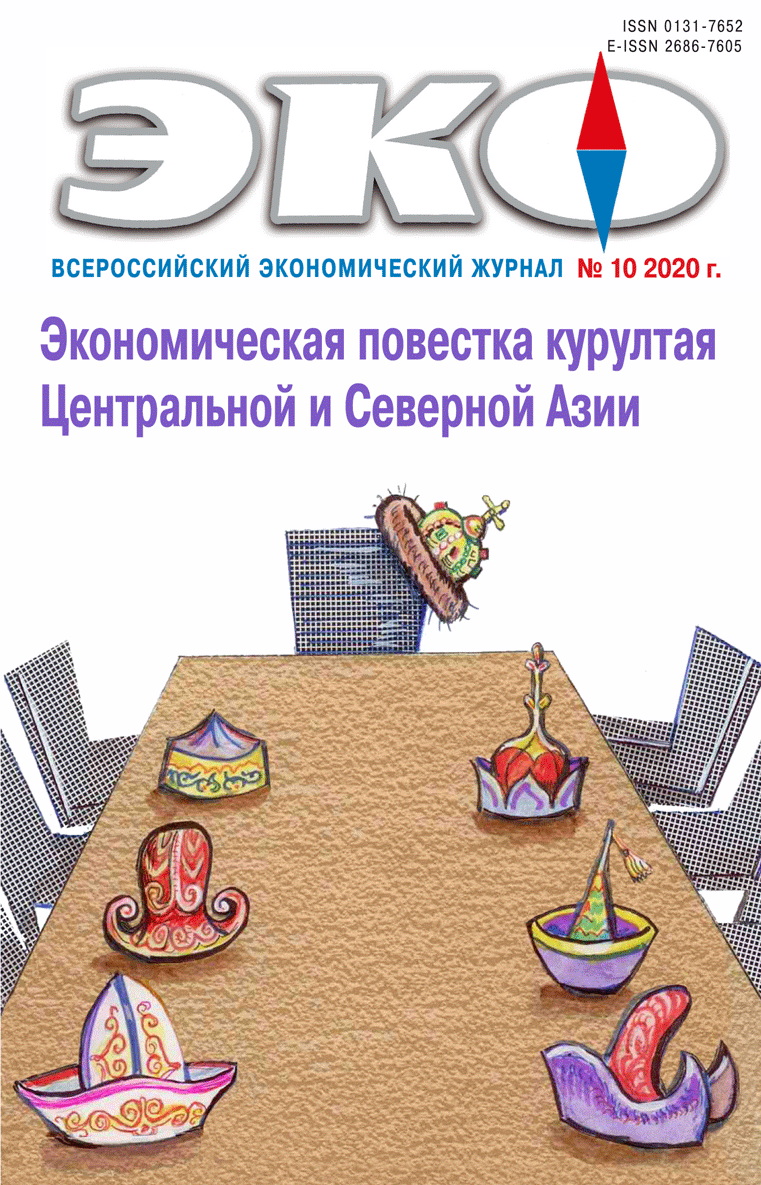Тема номера: ЭКОНОМИЧЕСКАЯ ПОВЕСТКА КУРУЛТАЯ ЦЕНТРАЛЬНОЙ И СЕВЕРНОЙ АЗИИ
The Mongolian Corridor: Problems and Prospects of Mongolian Transport Network Development
Published 2020-10-02
Keywords
- Mongolia,
- Russia,
- China,
- international economic cooperation,
- transport infrastructure
- railage,
- economic corridor development ...More
How to Cite
1.
Makarov А, Makarova Е, Andreev А. The Mongolian Corridor: Problems and Prospects of Mongolian Transport Network Development. ECO [Internet]. 2020 Oct. 2 [cited 2025 May 10];50(10):34-49. Available from: https://ecotrends.ru/index.php/eco/article/view/4126
Abstract
The paper analyzes problematic issues of the transit-transport network development of Mongolia affecting the current policy of Russian-Mongolian cooperation in the area of railway transport. The authors discuss plans of forming railway corridors within the framework of the China-Mongolia-Russia Economic Corridor Development Program.Particular attention is paid to analysis of dynamics, structure and routes of freight flows. It is concluded that the underdeveloped Mongolian transport infrastructure is a serious limitation to increase further exports. The initiatives of Russia and China in development of the railway network in Mongolia are examined. It turns out that they were not implemented due to government’s fears of an increasing role of neighboring countries in the Mongolian economy. It is shown that the Mongolian leadership, using transit rhetoric, continues to attract the maximum number of external partners to improve conditions for entering foreign markets and at the same time maintain its economic independence.Proposals to form a strategy for cooperation between Russia and Mongolia in the field of railway infrastructure development are made. Further participation of Russia in the Central Corridor development is considered as a key area of bilateral cooperation.References
- Борисов Г. О., Дондоков З. Б.-Д., Намжилова В. О. Экономический коридор Китай – Монголия – Россия: режим ожидания // ЭКО. 2017. № 5. С. 98–106
- Borisov, G.O., Dondokov, Z.B.-D., Namzhilova, V.O. (2017). Economic corridor China – Mongolia – Russia: standby mode. EСO. No. 5. Рp. 98–106. (In Russ.).
- Винокуров Е. Ю., Лобырев В. Г., Тихомиров А. А., Цукарев Т.В. Транспортные коридоры Шелкового пути: потенциал роста грузопотоков через ЕАЭС. СПб: ЦИИ ЕАБР, 2018. 74 с.
- Vinokurov, E. Yu., Lobyrev, V.G., Tikhomirov, А.А., Tsukarev, T.V. (2018). Silk Road Transport Corridors: potential for growth in cargo traffic through the EEU. St. Petersburg.: CIS EАDB., 74 p. (In Russ.).
- Грайворонский В. В. Модернизация железнодорожного транспорта в Монголии и роль российско-монгольского сотрудничества // Восточная аналитика. 2011. № 2. С. 123–130.
- Grayvoronsky, V.V. (2011). Modernization of railway transport in Mongolia and the role of Russian-Mongolian cooperation. Eastern analytics, No. 2. Рp. 123–130. (In Russ.).
- Макаров А. В., Макарова Е. В., Михеева А. С. Внешнеэкономические связи Монголии: современная ситуация и проблемы развития // ЭКО. 2019. № 6. С. 62–82.DOI: 10.30680/ЕСО0131–7652–2019–6–62–82
- Makarov, A.V., Makarova, E.V., Mikheeva, A.S. (2019). Foreign economic relations of Mongolia: current situation and development problems. EСO. No. 6. Рp. 62–82. (In Russ.). DOI: 10.30680/ЕСО0131–7652–2019–6–62–82
- Чепуркин Ю. В. Международный проект «Программа технической модернизации и развития АО “Улан-Баторская железная дорога” до 2020 года» // Бюллетень ученого совета Института экономики и развития транспорта. 2016. Вып. 1. С. 19–27.
- Chepurkin, Yu.V. (2016). International project «Program for technical modernization and development of Ulan-Bator Railway». Bulletin of the Economics and Transport Development Institute, No. 1. Рp. 19–27. (In Russ.).
- Erdenechimeg, E. (2016). Logistics and transport challenges in Mongolia. The Northeast Asian Economic Review. No. 2. Рp. 21–37.
- Gupta, P., Li, B.G., Yu, J. (2015). From Natural Resource Boom to Sustainable Economic Growth: Lessons for Mongolia. IMF Working Paper, WP/15/90. 31 p.
- Managing for development results: Rail infrastructure tariffs – enabling private sector development in Mongolia’s railway sector. Asian Development Bank, 2014. Available at: https://www.adb.org/sites/default/files/publication/31216/rail-infrastructure-tariffs-mongolia.pdf (accessed 05.12.2017).
- Mongolia: Road sector development to 2016. (2011). Asian Development Bank. Available at: https://www.adb.org/sites/default/files/publication/29626/mon-road-sector-development-2016.pdf (accessed 30.10.2017).
- Mongolia. Taming the tyrannies of distance and isolation: a transport strategy for Mongolia. (1999). Washington, DC: World Bank, 66 p.

